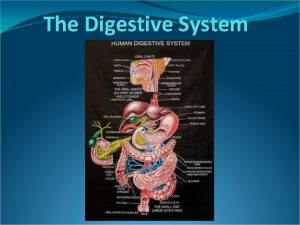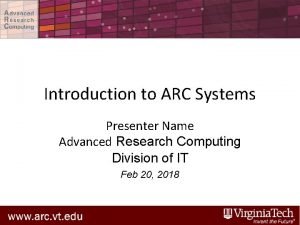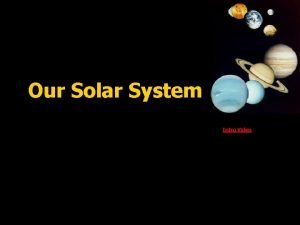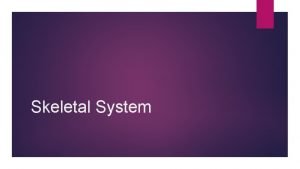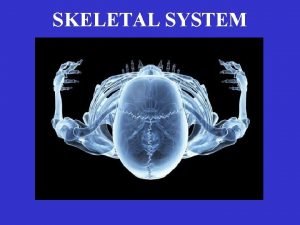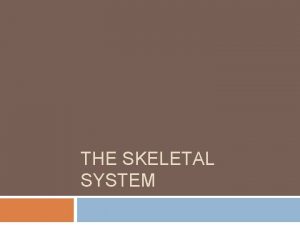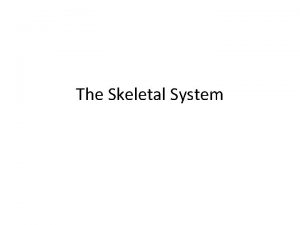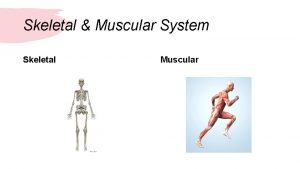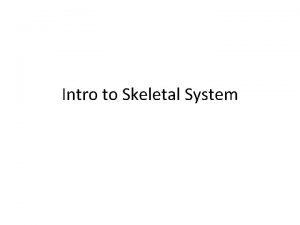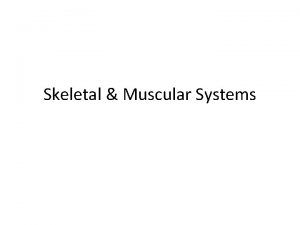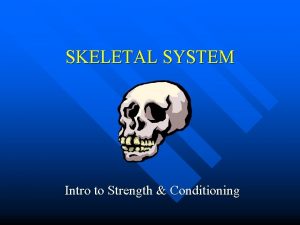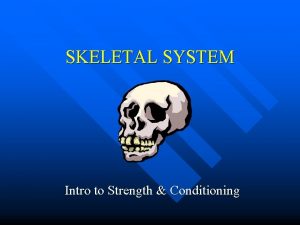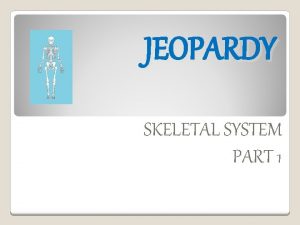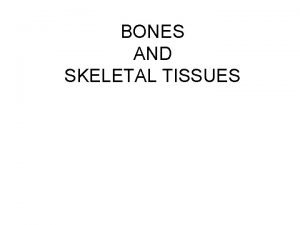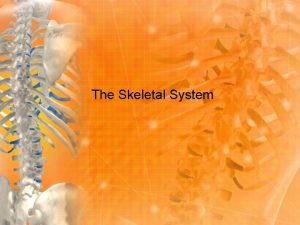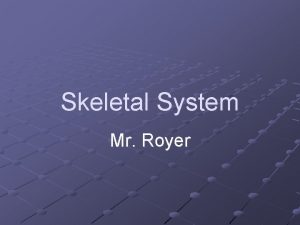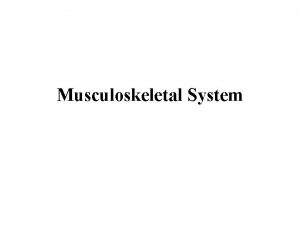THE SKELETAL SYSTEM INTRO TO SKELETAL SYSTEM 5



























- Slides: 27

THE SKELETAL SYSTEM INTRO TO SKELETAL SYSTEM (5: 08)

Functions of Skeleton � _____ � Hematopoiesis � Stores mineral _____ (____ & ____) � Provides sites for _____ attachment

Two Major Divisions � Axial – _____, hyoid, _____ cage � Appendicular – _____, pelvic/pectoral girdles

Bone Anatomy Periosteum – tough outer covering; _____ connective; contains _____ that enter and service bone cells � Medullary cavity – inner cavity of diaphysis; houses _____ marrow (_____ cells) � Epiphysis – end of long bone; contains epiphyseal disk (region of _____); _____ bone; covered with articular (hyaline) cartilage; _____ marrow (hematopoiesis) � Diaphysis – middle shaft of bone; mostly _____ bone �

Bone Marrow Cross section of femoral head

Bone Anatomy � Endosteum – inner lining of _____ cavity; connective tissue covered with simple squamous; highly vascular (full of _____) � Canaliculi – microscopic canals within bone tissue through which bone cells _____ with each other and to the _____ supply � Lacunae – microscopic chambers that house osteocytes (mature _____)

Bone Anatomy

Two Types of Bone � Spongy – many _____ (lowers _____); spaces filled with _____ marrow; trabeculae (give _____) � Compact – dense; lacks _____; central canal (houses blood vessels and nerves); lamellae (concentric layers) around _____ canal (Haversian system); Haversian systems are closely packed, hence _____ bone

Two Types of Bone Central canal Haversian System (or osteon)

Internal Bone Anatomy

Bone Growth Osteo. Blasts – cells that B_____ up bone; make new matrix then mineralize it via e_____ � Osteo. Clasts – cells that C_____ bone; dissolve the mineralized matrix of bone by releasing H+ ions (acidic) then digest it with_____; dissolved minerals put into blood stream when needed; contain many vesicles – Why? ? �Osteoblasts and osteoclasts work together to maintain bone structure _____. �Explain braces on teeth � Epiphyseal disk – “_____”; cartilaginous tissue (hyaline) where _____ occurs; ossification begins around 17, ends around 25; process regulated by _____ �

Bone Growth Adult Hand of a 3 -year Old (lots of cartilage) (White = dense; Gray/Black = less dense)

Bone Repair Hematoma – _____ clot, inflammation, pain Fibrocartilage callus – mass of collagenous fibers and fibrocartilage fills in space of breakage; _____ cells move in and clean up; reconstruction begins � Bony callus – o_____ move in and ossify fibrocartilage callus into spongy bone � Remodeling – _____ build up compact bone and _____ break down the spongy bone and build new medullary cavity. In general, � � � a. _____ break down bone, remove worn cells, and deposit ______ in the blood. � b. After about 3 weeks, the osteoclasts disappear. � c. Then, _____ reverse work done by osteoclasts, taking Ca from the blood and depositing it in _____. � � Skeletal System Overview (3: 45) Remolding Animation (2: 44)

Fractures � Two main types: �Simple – bone is broken, but _____ is not lacerated ○ Transverse – fracture occurs at right angle of bone ○ Greenstick – fracture on one side of the bone ○ Comminuted – fracture that results in three or more bone _____ �Open/Compound – bone breaks and lacerates the _____; risk of _____

Fractures Greenstick Transverse Types of Fractures (2: 07) Compound Comminuted

Treatments for Broken Bones � Four Treatments: �C_____ �S_____ (in which screws and/or rods can be used) �Electrical stimulation (speeds up _____, suppresses osteo_____ function) �Ultrasound (speeds up _____, stimulates chondrocytes to make callus)

The Skull � Sinuses – _____ skull; voice resonance; _____ buffer; air humidifier; lots of mucous membranes; sinusitis (_____ cannot drain properly due to _____)

The Skull � Fontanels – “_____”; occur because of the protein noggin (delays _____ of cranial bones) � Sutures – held together by _____ connective tissue

The Spine � Abnormal curvatures: � _____ (pregnancy, big gut) � _____ (hunchback) � _____ (lateral curvature) � Possess many processes for _____ attachment (transverse and spinous) � Intervertebral disks (can _____ under stress) � Name of C 1 and C 2? (______ & ______)

Spine Anatomy

The Spine (abnormal curvatures) Kyphosis Scoliosis

The Spine (herniated disk) Herniated disk treatments (3: 11)

Joints (Don’t be “SAD”!) � Three basic types of joints: �_____ (immovable; sutures) �_____ (slightly movable; vertebral joints) �_____ (freely movable; synovial; elbow, shoulder, etc. )

Disorders � Sprains �overstretching of a _____ or _____ � Rheumatoid arthritis �chronic _____ inflammatory disorder that typically affects joints in your hands and feet � Osteoarthritis �the most common form of arthritis; occurs when _____ in joints wears down over time � Gout �occurs when sharp, needle-like uric acid crystals accumulate around joint, causing _____ and intense _____

Disorders

Effects of Aging Cartilage calcifies � Osteoporosis � Slower, less effective healing – Why? � Marrow transformation as we age: � � Infants – almost entirely red � Middle age – 50: 50 red to yellow � Elderly – almost entirely yellow � Osteoporosis (5: 05)

Bone Art by Marian Caparu
 Introduction to digestive system
Introduction to digestive system Digestive system introduction
Digestive system introduction Arc system intro
Arc system intro Solar system intro
Solar system intro Hình ảnh bộ gõ cơ thể búng tay
Hình ảnh bộ gõ cơ thể búng tay Lp html
Lp html Bổ thể
Bổ thể Tỉ lệ cơ thể trẻ em
Tỉ lệ cơ thể trẻ em Gấu đi như thế nào
Gấu đi như thế nào Thang điểm glasgow
Thang điểm glasgow Chúa sống lại
Chúa sống lại Các môn thể thao bắt đầu bằng tiếng bóng
Các môn thể thao bắt đầu bằng tiếng bóng Thế nào là hệ số cao nhất
Thế nào là hệ số cao nhất Các châu lục và đại dương trên thế giới
Các châu lục và đại dương trên thế giới Công thức tính thế năng
Công thức tính thế năng Trời xanh đây là của chúng ta thể thơ
Trời xanh đây là của chúng ta thể thơ Cách giải mật thư tọa độ
Cách giải mật thư tọa độ 101012 bằng
101012 bằng Phản ứng thế ankan
Phản ứng thế ankan Các châu lục và đại dương trên thế giới
Các châu lục và đại dương trên thế giới Thơ thất ngôn tứ tuyệt đường luật
Thơ thất ngôn tứ tuyệt đường luật Quá trình desamine hóa có thể tạo ra
Quá trình desamine hóa có thể tạo ra Một số thể thơ truyền thống
Một số thể thơ truyền thống Cái miệng xinh xinh thế chỉ nói điều hay thôi
Cái miệng xinh xinh thế chỉ nói điều hay thôi Vẽ hình chiếu vuông góc của vật thể sau
Vẽ hình chiếu vuông góc của vật thể sau Biện pháp chống mỏi cơ
Biện pháp chống mỏi cơ đặc điểm cơ thể của người tối cổ
đặc điểm cơ thể của người tối cổ Thế nào là giọng cùng tên? *
Thế nào là giọng cùng tên? *

